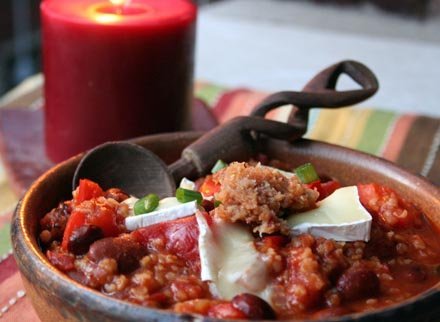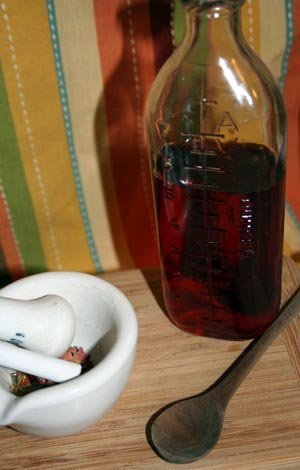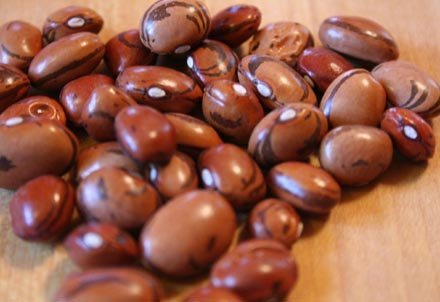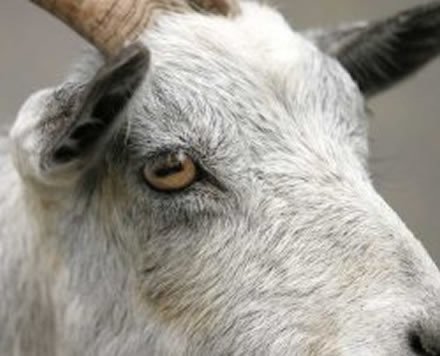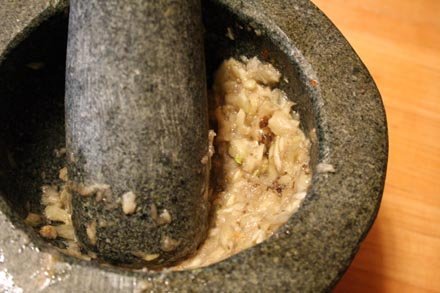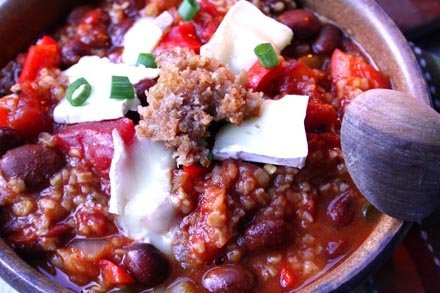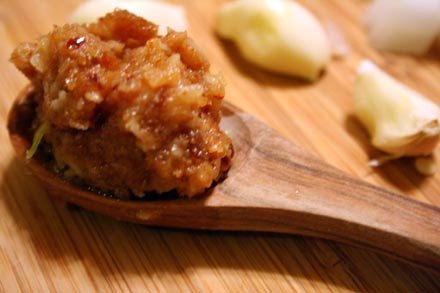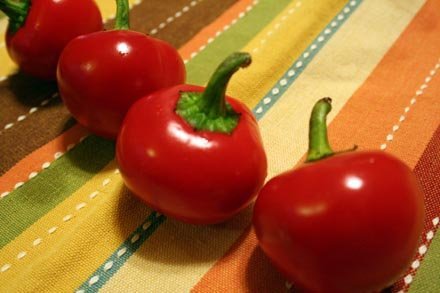(Vegetarian, vegan option)
The Hallowe’en season is creeping down upon us, after all. I’ve been saving the Eye of the Goat for something special, and this brisk, rainy, gothic weather in the mid-portion of October seems just the thing. Time to call in my potions and lotions and pestles and powders, to make something with teeth. Something dangerous, even. With a robust dose of vampire-repellant.
What’s that? We’re only in the first full week of the month? Samhain spirit gets me early, I guess. The trees are just turning warm, and now and then I catch the low pitch of the North wind in a periodic gust. Global climate change has made it hard for a girl who lives her year by the seasonal calendar, but somehow, autumn always manages to shake through. For this I am grateful. And so I cook.
This chili is for my friend Amy. She doesn’t like chili. Or, as she ruefully says, she can’t stomach “a heaping, fogging bowl of onion-piled, fat roach-bean ridden chili and a side of…” (and here she pauses to shudder), …”mealy corn bread”. Oh, Amy. Who can blame her? Here, then, is her antidote.
There’s no epidemic of plumped up brownish-red beans in this stew. And not a whole onion in the entire pot. More or less, this is a Bittman recipe – minimalist, straightforward, and big on flavor. I’ve adapted it from his book, How to Cook Everything Vegetarian (if you don’t know this book, you ought to, even if you’re from the meat-eating camp). My version relies on a variety of peppers, tomatoes, and a hefty topping of garlic for its flavor; the satisfying texture comes from bulgur.
Often featured in Turkish, Middle Eastern and Mediterranean dishes, bulgur is a germinated grain, usually made from durum wheat. Bulgur has a happy quirk: when it’s cooked, much of its nutritional content actually permeates the kernel rather than leaching out, thus lending it a more highly nutritious profile than many other wheat products. A cup of cooked bulgur lands you 8 grams of fiber and six grams of protein. Perhaps more importantly, it carries a nutty flavor and a chewy texture, letting it fill in nicely for meat.
But back to the goat’s eyes.
I have a thing for goats. Someday, I hope to keep them as pets. I’m a tad obsessed with them. And I plan them into my vacations. Seriously. When we travel to the West Coast, we’re making two pit stops at goat farms. (Sorry Simon…)
Handel once said that when he was composing the Hallelujah Chorus for his great work, Messiah, he saw the heavens open up and the face of God shone directly on him, inspiring his opus. I feel the same about goats – who can say why? They make me laugh. They make me sing. They are perfect little creatures. I could never harm a goat.
But you can imagine that I got excited when I came across an heirloom bean called Ojo de Cabra (I don’t know much Spanish these days but I know the word for goat). Named because the tan and brown speckled beans have swirls and slash marks that conjure a pygmy’s face (ok, sort of. See goat photo for comparison), these beans are sweet, rich, nutty and meaty. Originally cultivated in Northern Mexico, they are a perfect match for the chewier bulgur in this chili recipe. I bought the beans from Rancho Gordo, but they have since sold out. Still, they’re surely not gone forever.
Two more things I have to tell you about before we get to the recipe. First, cheese belongs on chili. The soft, creamy sort, one that only has to get caught up in the chili’s steam to begin melting. I had a gorgeous Camembert on hand, sent to me courtesy of Ile de France, and it was lovely. The milky, full-bodied cheese smoothed the heat from the hot peppers without muting them. You can read my review of the cheese here, but know that you won’t go wrong with a Camembert or Brie as a chili topper.
If the month of October gets you worried about vampires dropping in, this chili topping will keep them at bay. Rouille (pronounced ru – ee’).is a French condiment that literally means rust, because of its color. Made with a whole lot of garlic and red pepper flakes, plus bread crumbs, red wine vinegar (hence the hue — see the second rouille photo, after the vinegar is added), olive oil and salt, the impact lies not so much in its heat (which isn’t ferocious, especially if you use just a dab) but in its intensity. The flavor is deep, round and everlasting. Rouille knows no restraint.
The Recipes
Bulgur Chili with Eye of the Goat (Beans)
2 tablespoons extra virgin olive oil
½ white onion, finely chopped
4 cloves garlic
3-4 fresh small peppers (like alma paprikas, pictured below), mixed heat
1 large red bell pepper
1 teaspoon aleppo pepper flakes
2 teaspoons ancho pepper flakes
2 tablespoons chili powder (pre-mixed is okay, or see recipe below)
1 4-ounce can tomato paste
1 28 ounce can chopped tomatoes with their juice
6 cups vegetable stock
1 dash of liquid smoke
2 cups Eye of the Goat beans (or other chili beans)
1 cup uncooked bulgur
Salt and Pepper to taste
Camembert and rouille for garnish (see rouille recipe below)
Heat the olive oil in a large stock pot over medium-high heat. When hot, add the onions and garlic and sauté for three minutes. Add the fresh hot peppers and the bell pepper and stir to coat with oil. Cook another four minutes, stirring now and then. Add the aleppo and ancho flakes/powder and the chili powder and stir. Cook another 2 minutes, stirring often. This will bring the flavor out of the seasonings.
Stir in the tomato paste and let warm slightly. Add the tomatoes, the veggie stock, the liquid smoke and the salt and pepper. Bring to a gentle boil, then reduce the heat and cook, covered, for 20 minutes. Stir in the beans and the bulgur and cook for another ten minutes.
Remove from heat and let sit for another 15 minutes, until the bulgur is plump and chewy. Taste again for salt and pepper. Serve hot, garnished with chives, thin slices of Camembert, and rouille.
Rouille
This recipe may look intimidating, but don’t be frightened. I’m not taking you on an extreme eating excursion — that’s your nickel. It can be as potent or as melodic as you make it. When just a bit of this is stirred into chili or soup (1/2 teaspoon), the flavors mellow and meld, giving the dish a depth without giving you a kick in the teeth. The flavor is bright and lively and I promise you, you won’t be sorry. Besides, think of all the antimicrobial, antibacterial and anti-vampiral properties in all that garlic and pepper! If you make it, tell me what you think.
¼ cup red wine vinegar
½ cup fresh, dried breadcrumbs
10 cloves garlic, peeled and chopped
1 teaspoon salt
a sprinkle of smoked salt (if you’re using this in chili – it makes all the difference)
2 teaspoons dried aleppo pepper or other hot red pepper flakes
½ cup extra virgin olive oil
Place bread crumbs in a bowl and pour the vinegar over them. Let stand for 30 minutes, then squeeze out the bread crumbs and discard any remaining vinegar.
Place the garlic in a mortar or bowl. Add the salts and slowly pound with the pestle until the garlic has become a paste. Add the Aleppo and the bread crumbs and pound again, incorporating all the ingredients into a balanced mix.
Add the olive oil, one tablespoon at a time, and pound with the pestle until the oil has been incorporated into the mix. You may not need all of the oil – you’re aiming for a paste that is moist but will hold its shape on a spoon.
Homemade Chili Powder (also from How to Cook Everything Vegetarian)
2 tablespoons ground ancho, New Mexico, or other mild chili
½ teaspoon cayenne
½ teaspoon fresh ground black pepper
2 teaspoons cumin seeds
2 teaspoons coriander seeds
1 teaspoon dried Mexican oregano
½ teaspoon salt

